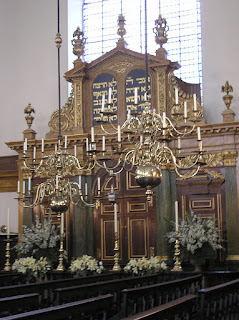 |
| Reconstruction of London's Roman waterfront, with London Bridge in the foreground, and the warehouses of Billingsgate behind, Museum of London. Photo: Steven G. Johnson (licensed under CCA). |
Throughout the Middle Ages, the wharves of Billingsgate seem to have been used for the loading and unloading of many and varied cargoes, including (according to the Elizabethan chronicler, John Stow), " ... fish, both fresh and salt, shell-fishes, salt, oranges, onions, and other fruits, and roots, wheat, rye and grain of divers sorts ... ."
Medieval Londoners ate a good deal of fish, not least because the Catholic Church forbade the consumption of meat on Fridays (to commemorate the crucifixion), Saturdays (in remembrance of the sorrows of the Blessed Virgin Mary), and Wednesdays (to mark Judas's acceptance of money in return for the betrayal of Christ); and throughout the four weeks of Advent, and the six of Lent. In Saxon times these restrictions were enforceable by law, but long after the legal constraints were lifted, peer-pressure and genuine piety seem to have ensured that most people followed the rules most of the time.
 |
| A fishmonger's stall, by Adriaen Van Utrecht (1599-1652). Image is in the Public Domain. |
For wealthy Londoners, a very wide variety of fish was available. Working from the late Fourteenth Century account book of Henry of Lancaster, the historian, Ian Mortimer, has shown that a fresh salmon, in season, sold for four or five shillings, and a turbot for seven, at a time when a skilled workman, such as a carpenter or thatcher, earned around two shillings a week. Lobsters and crabs were kept alive in barrels.
 |
| A fishmonger's stall, by Frans Snyders (1579-1657). Image is in the Public Domain. |
Fish was brought to London, not only travelling up-river from the sea, but also down-river from river fisheries (freshwater fish included eel, pike, trout, perch and rudd), where fish-weirs and traps were in widespread use. So numerous did these inland fisheries become that Edward III saw the need to restrict them:
" ... because the free passage of ships and boats in the great rivers of England is often disrupted by the raising of gorces, mills, weirs, stakes and kiddles, to the great damage of the people, it is agreed and established that all such ... which were raised and placed in such rivers in the time of the King's grandfather and thereafter, by which ships and boats are disturbed so that they cannot pass as they are accustomed, shall be removed and completely demolished ... ."
 |
| A derelict fish-trap at Drumdowney, County Kilkenny, Ireland. Photo: Kieran Campbell (licensed under CCA). |
Enforcement of these rules, of course, depended on local officials, whose zeal would depend on their location (and, quite possibly, on bribes). Fish weirs might not be allowed on great rivers such as the Thames, but they almost certainly continued to be used on its tributaries, including the Fleet, the Lea, the Ravensborne and the Mole.
Some tasty Medieval recipes for fish: including cod poached in white wine; fish sausage with currants, cloves, saffron and mace; salmon pie with parsley, sage, ginger, pepper and anise; and eel pie with onions, raisins, pepper and ginger; can be found at www.medievalcookery.com/recipes. Such dishes, with their expensive foreign spices, were only for the affluent, although a more modest version could, in each case, be made, flavoured with the garlic and parsley that were on sale in the streets of Billingsgate Ward. For the average working family, salt cod, salted and pickled herrings, mackerel, eels, cockles and mussels were very much more affordable.
Throughout the Fifteenth Century, a flourishing trade in salted cod existed between England and Iceland, with the English ships sailing out between February and April, and returning between July and September. The herring fleets brought their catch to the city in the autumn, and always in two varieties: white herring (preserved in salt) and red herring (salted and smoked for double protection). The latter were always cheap and plentiful, but were not always enjoyed, people being all to ready to give them up in favour of meat as Christmas and Easter approached.
 |
| Billingsgate in 1808, by Thomas Rowlandson and Augustus Charles Pugin (image is in the Public Domain). |
By the beginning of the Nineteenth Century, Billingsgate had become the largest fish-market in the world, but it sprawled chaotically along the wharves and streets of the ward, and "to speak Billingsgate" became a bye-word for obscenity. Only in 1870 was a covered market established, designed by the City Architect, Sir Horace Jones, and this lasted for little more than a hundred years. In 1982, the fish-market was removed from the City, and relocated in Docklands.
 |
| Billingsgate c.1888, from "The Queen's Empire," Volume 4, Cassell & Co. (image is in the Public Domain). |
 |
| Sir Horace Jones's Billingsgate Market today, now converted into offices. Photo: Steve F-E-Cameron (licensed under GNU). |
Today, there is not a herring or an eel to be had in "Old Billingsgate," but frozen, as well as fresh and salted, fish are freighted to "New Billingsgate" on a daily basis, and, at six o'clock in the morning, clusters of Chinese, Caribbean, Indian and Middle Eastern restaurateurs can be observed haggling over the price of fish.
Mark Patton's novels, Undreamed Shores, An Accidental King, and Omphalos, are published by Crooked Cat Publications, and can be purchased from Amazon. He is currently working on The Cheapside Tales, a London-based trilogy of historical novels.




































